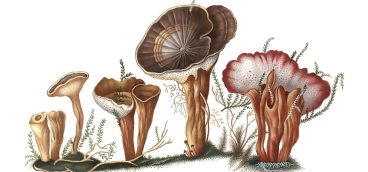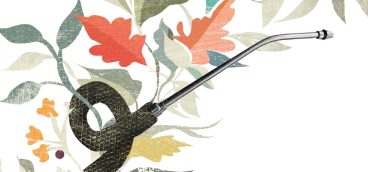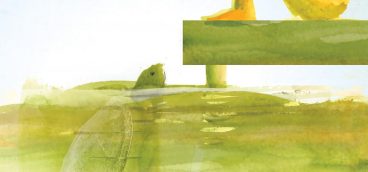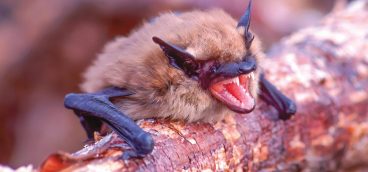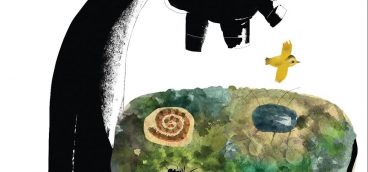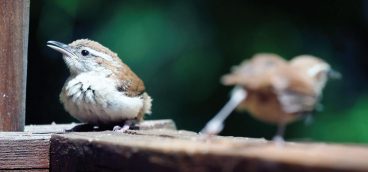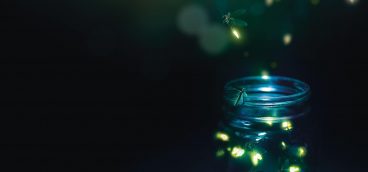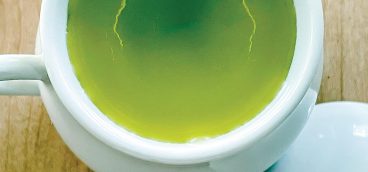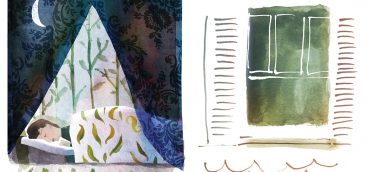Poison Ivy Flourishes on Carbon Dioxide
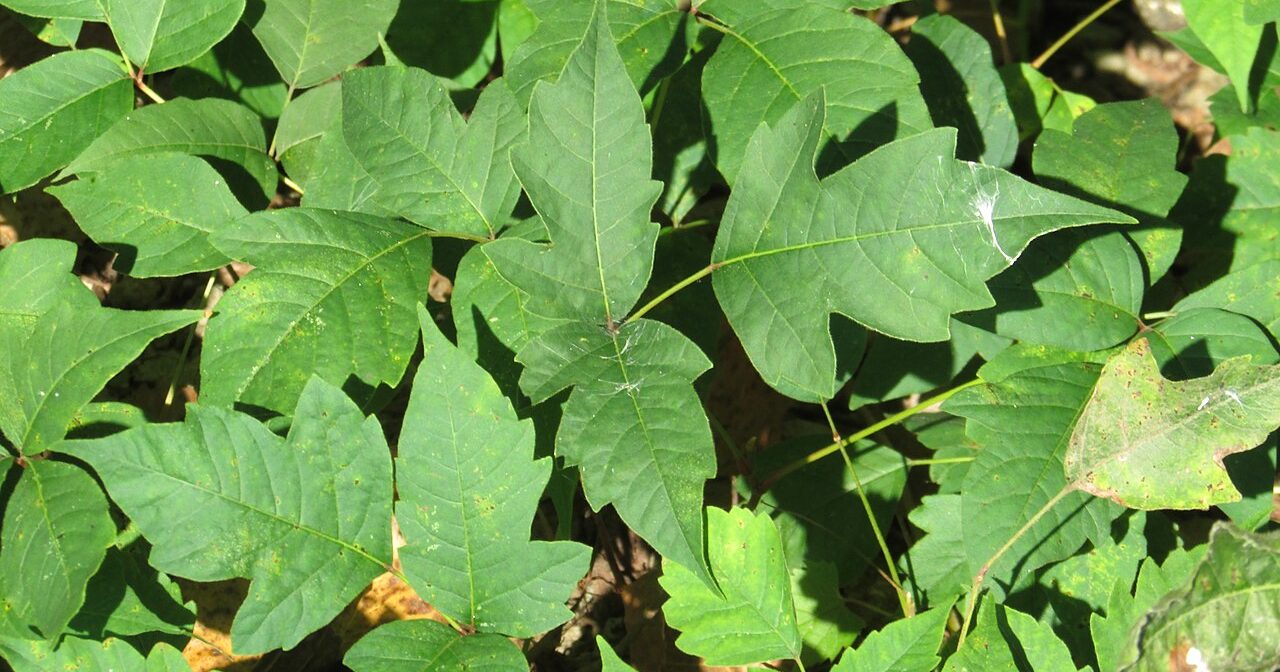
One of my husband’s first tasks when we moved to the farm 36 years ago was to remove poison ivy from the trees. He never used chemicals, just his two (gloved) hands. He came home time and time again with poison ivy pustules on his wrists that leaked liquid for three weeks. “A fool’s errand,” he said.
A fool’s errand not just because poison ivy is difficult to eradicate, but because the plant doesn’t usually harm trees. I’d read that poison ivy blocks the sun, weakens trees, and weighs down branches that break more easily in high wind, but Susan Pell, poison ivy expert and executive director of the U.S. Botanic Garden in Washington, D.C., said not necessarily. Poison ivy might harm young or sick trees, she said, but “the native species in the forest have evolved together so it’s not really a big issue.”
For those allergic to poison ivy — and that’s 80-90 percent of us — it may be disconcerting to learn that poison ivy is thriving because of climate change. Many woody plants grow better with more carbon dioxide in the atmosphere, but poison ivy stands out. In a six-year study at the Duke University Forest, carbon dioxide was pumped artificially into a controlled setting to mimic climate scenarios. “Poison ivy was the fastest growing of all plants studied,” Pell said. It topped the chart, growing 70 percent faster. Its leaves grew larger, and the urushiol — the oily ingredient that causes the rash — became more virulent.
All it takes to get a rash from poison ivy is the slightest touch, or “50 micrograms of urushiol, an amount that is less than one grain of table salt,” according to the Centers for Disease Control and Prevention. Every part of the plant is poisonous but “the rash is not directed at us,” Pell said. Urushiol is anti-bacterial and anti-fungal and may protect the plant against infection. Poison ivy also has a host of redeeming qualities. Its berries — or drupes — are food for many birds. Deer, black bear, rabbits and other animals eat the plant (they disperse the seeds; the plant spreads by rhizomes too). Some insects also eat the plant, and poison ivy’s leaves provide shelter for them. The plant helps prevent erosion.
Its Latin name, Toxicodendron radicans, means “poison tree” and it is in the Anacardiaceae, or cashew, family, which includes mango, pistachio, sumac, and smoke tree. Many poisonous plants exist in that family but “poison ivy is the most notorious,” Pell said. The plant grows in every state except California and tends to grow in disturbed areas such as pathways and the forest edge where light is more abundant. It comes in many forms: as a groundcover, as a large vine called a liana, and as a shrub. I’ve never seen the shrub version, but Pell has: six feet high on the New Jersey coast with slick black bark. On our farm, we have lianas smack in the middle of our woods, where I presume a tree had toppled and allowed in more light. Those vines — which my husband was tackling — are so big and hairy and that when they climb a tree, the leaves are difficult to distinguish from those of the host tree.
Poison ivy is a Pennsylvania native and it is also being studied right here at home, but in a different manner. Mason Heberling, associate curator of botany at the Carnegie Museum of Natural History, has retrieved, from the museum’s herbarium, 327 specimens of poison ivy, poison sumac, staghorn sumac and Virginia creeper that had been collected across Pennsylvania from 1838 to 2020. By looking at dried and pressed leaves, flowers, and branches, he has confirmed that with increased CO2, poison ivy has “shifted several traits.” Leaf size has increased, the number of pores on the leaves has decreased, and its water use has declined. His results were published last October in the American Journal of Botany, and although he’s not yet sure what those results mean exactly, he’ll continue to study what he called an under-collected and understudied plant.
To put greenhouse gases in perspective, Heberling told me that in the 19th century, CO2 measured around 285 parts per million; today, it measures nearly 420 parts per million and is “rising each year.” The leading explanation for poison ivy’s fast growth is its vining habit, he said. The plant doesn’t have to invest as much energy into making wood and it “cheats by climbing up trees.” Poison ivy’s increased vigor may indeed harm forests in the future. According to Duke, “Rising CO2 is potentially responsible for the increased vine abundance that is inhibiting forest regeneration and increasing tree mortality around the world.”
Poison ivy is a common allergen and researchers worry that with faster growth and increased urushiol, people will get rashes more easily and have more severe attacks. The best thing is to avoid the plant, of course, but to do so one must be able to recognize it and identification can be tricky. The common adage, “Leaves of three, let it be,” is meant to help us, but Pell has seen poison ivy with five leaflets (the scientific term) in Boston and Texas. Leaves can be large or small, shiny or dull, margined or lobed, and, in autumn, they turn a brilliant red, one of the first plants to change color. “One thought is that the bright red leaves of fall are to attract migrating birds to its fruit,” Heberling said. Look-alikes include Virginia creeper, blackberry, and box elder.
Pell thinks it’s important for everyone to recognize poison ivy. “It’s common in so many areas in which people spend time that almost everyone in the eastern U.S. is likely to encounter it,” she said. “People often think of it being only in and near forests, but it’s also at the beach growing in the dunes, in yards and gardens, and in urban areas. I’ve seen it growing over and along bike paths, growing on fences along sidewalks and at train stations in numerous cities, and even growing out of roof gutters.”
One problem may be what’s called “plant blindness,” when people don’t recognize plants or can’t tell one plant from another. “People don’t see the diversity in front of them,” Pell said. “Some people don’t understand that plants are even alive. That’s a big issue, from a conservation standpoint. If people can’t recognize a plant, they can’t appreciate it.”
People also don’t realize that poison ivy can remain on clothes, garden tools, and pet fur for a long time. Plants are still poisonous in winter. Even dried plants can transmit the rash. Fires can cause urushiol to get into lungs, so don’t burn it, and don’t weed-whack it. According to Penn State, the best way to control poison ivy is “repeatedly amputating the vine at its source.” That was my husband’s method.
Pell recommends washing affected areas with old-fashioned soap and water, preferably cold. Hot water opens the skin’s pores and allows urushiol to enter more easily. Being fond of natural remedies, I have often rubbed jewelweed — which can grow near poison ivy — on my skin after exposure, but I was disappointed to learn from Pell that jewelweed does not counter the urushiol.
Three and a half decades later, my husband no longer gets poison ivy. He spends at least as much time, if not more, in the forest and believes he has built up an immunity, but Pell said science doesn’t support his theory. On the other hand, she has heard anecdotes of lighter symptoms, or hypo-sensitization, occurring in people who work in the lacquer industry, where urushiol is harvested from the Japanese Lacquer Tree to create lacquerware.
Time — and exposure — will tell.



